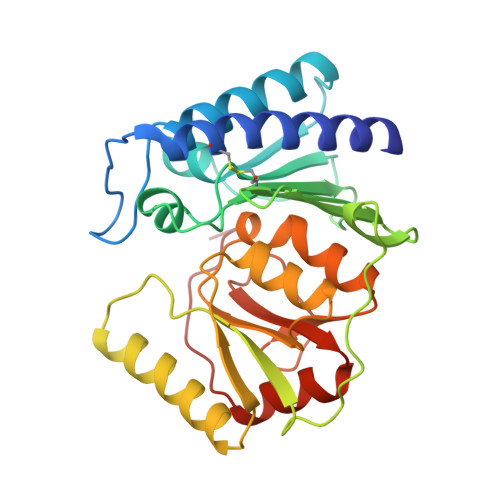Structural analysis of inositol monophosphatase complexes with substrates.
Bone, R., Frank, L., Springer, J.P., Pollack, S.J., Osborne, S.A., Atack, J.R., Knowles, M.R., McAllister, G., Ragan, C.I., Broughton, H.B., Baker, R., Fletcher, S.R.(1994) Biochemistry 33: 9460-9467
- PubMed: 8068620
- DOI: https://doi.org/10.1021/bi00198a011
- Primary Citation of Related Structures:
1IMA, 1IMB - PubMed Abstract:
The structures of ternary complexes of human inositol monophosphatase with inhibitory Gd3+ and either D- or L-myo-inositol 1-phosphate have been determined to 2.2-2.3 A resolution using X-ray crystallography. Substrate and metal are bound identically in each active site of the phosphatase dimer. The substrate is present at full occupancy, while the metal is present at only 35% occupancy, suggesting that Li+ from the crystallization solvent partially replaces Gd3+ upon substrate binding. The phosphate groups of both substrates interact with the phosphatase in the same manner with one phosphate oxygen bound to the octahedrally coordinated active site metal and another oxygen forming hydrogen bonds with the amide groups of residues 94 and 95. The active site orientations of the inositol rings of D- and L-myo-inositol 1-phosphate differ by rotation of nearly 60 degrees about the phosphate ester bond. Each substrate utilizes the same key residues (Asp 93, Ala 196, Glu 213, and Asp 220) to form the same number of hydrogen bonds with the enzyme. Mutagenesis experiments confirm the interaction of Glu 213 with the inositol ring and suggest that interactions with Ser 165 may develop during the transition state. The structural data suggest that the active site nucleophile is a metal-bound water that is activated by interaction with Glu 70 and Thr 95. Expulsion of the ester oxygen appears to be promoted by three aspartate residues acting together (90, 93, and 220), either to donate a proton to the leaving group or to form another metal binding site from which a second Mg2+ coordinates the leaving group during the transition state.
Organizational Affiliation:
Department of Biophysical Chemistry, Merck Research Laboratories, Rahway, New Jersey 07065.
















